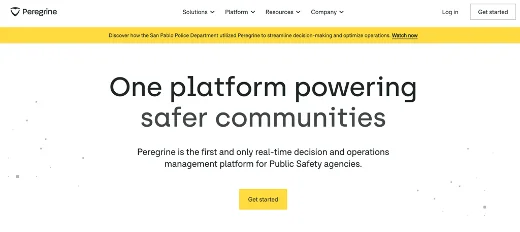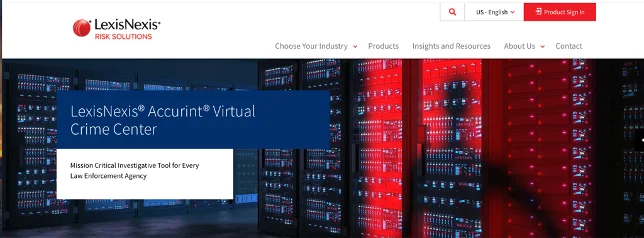The contemporary law enforcement agency relies on technological tools to optimize the utilization of limited resources and personnel. Among these tools, a crucial asset is a law enforcement data management system that facilitates seamless access, consolidation, and organization of all pertinent information necessary for conducting successful investigations. In our observation, agencies exploring Peregrine alternatives seek law enforcement data management platforms that:
- Enhance officers’ situational awareness and bolster officer safety.
- Democratize data access, enabling field officers to obtain required information promptly and independently of crime analysts.
- Prioritize user-friendliness to ensure swift and effortless information retrieval, as overly complex processes impede investigative progress.
- Interface with a wide array of data sources, simplifying the task of assembling the investigative puzzle.
- Seamlessly integrate with other investigative software, such as case management platforms, to facilitate lead prioritization, task organization, and resource management.
- Enable the transmission and receipt of time-sensitive or emergency alerts, fostering immediate sharing across departments and jurisdictions to enhance real-time public safety.
Note: CrimeTracer’s law enforcement data management system includes all the features just discussed. You can read about it in detail below or reach out to our sales team to learn more about how CrimeTracer can help your agency expedite investigations.
Peregrine positions itself as a cutting-edge platform for real-time decision-making and operational management. It empowers patrol officers by furnishing contextual insights to enhance situational awareness. Officers can access up-to-the-minute information from dispatch, analysts, and crime centers using their mobile phones.
Beyond its law enforcement capabilities, Peregrine serves as a unified platform for orchestrating the efforts of various public safety agencies, encompassing fire departments, event security, and law enforcement alike.
What Are the Leading Peregrine Alternatives?
Although numerous agencies have integrated Peregrine into their investigative methodologies as a pivotal tool, it may not align with every requirement and scenario.
In this article, we will introduce alternatives to Peregrine, with a particular focus on CrimeTracer’s law enforcement data management system and its array of features that render it an enticing option for agencies to explore.
Peregrine Alternative # 1: CrimeTracer
CrimeTracer, formerly recognized as COPLINK X, stands as a robust search engine granting access to over 1 billion local and state law enforcement records, supplemented by billions more sourced from the National Data Exchange (N-DEx), the Law Enforcement Information Exchange (LinX), the Thomson Reuters CLEAR database of public records, and various other repositories.
Through the utilization of natural language search terms and concepts, CrimeTracer excels in generating top-tier search outcomes that can accelerate investigative processes. Moreover, the software boasts the ability to produce link charts illustrating connections among individuals, vehicles, and other entities discovered within the searched records. It also offers geographical maps delineating crime prevalence in specific regions, serving as invaluable resources for command staff, investigative teams, and the broader communities they serve.
Key Feature #1: Rapid Search Capability Enhances Situational Awareness and Protects Officer Safety
For officers and investigators who frequently operate in the field, responding to incidents, attending crime scenes, and interacting with witnesses, tools that enhance situational awareness and prioritize officer safety are paramount. CrimeTracer furnishes essential historical information, furnishing field officers with the contextual understanding necessary to ensure their safety.
For instance, whenever a user conducts a search using a name, license plate, or address, the system automatically consolidates and presents a comprehensive list of every interaction associated with that entity. By reviewing the list of incident types, officers can swiftly grasp an overview of all previous involvements of the targeted individual, vehicle, or location, irrespective of the involved agencies. CrimeTracer generates a “Tag Cloud” featuring the most prevalent names, plates, and addresses linked to any queried person, place, or object, facilitating investigative teams in identifying patterns. In contrast, similar searches conducted within the National Crime Information Center (NCIC) or against state Department of Motor Vehicles (DMV) systems do not yield such extensive data richness.
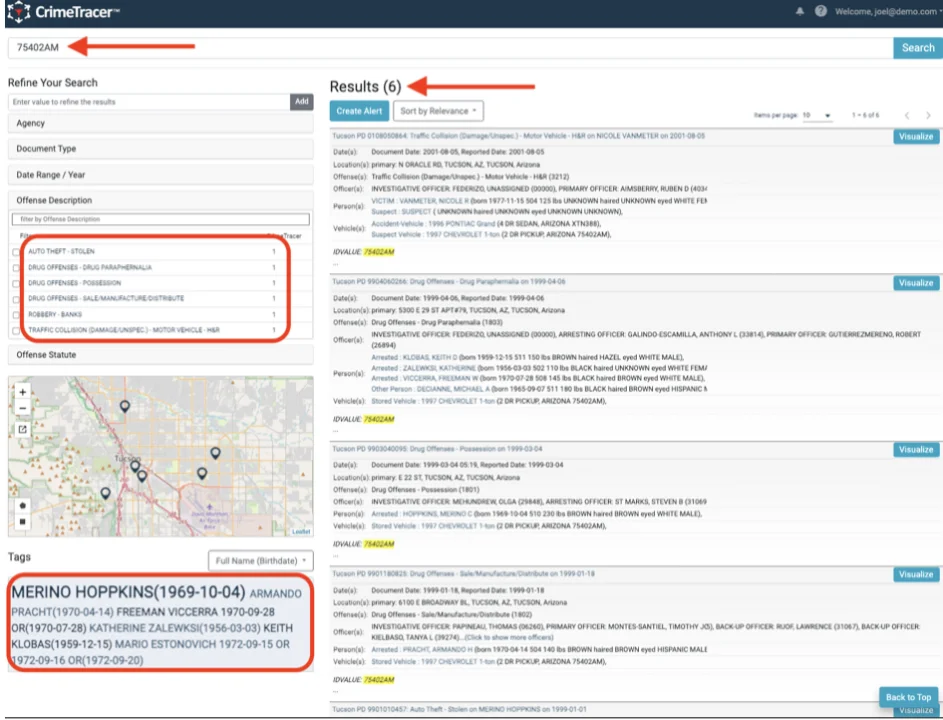
An example of a license plate number lookup and a list of offenses connected to the associated vehicle.
Likewise, utilizing CrimeTracer’s Person search feature, an investigator can access a comprehensive overview of all activities involving a potential suspect, including locations where they are frequently encountered, as determined by their documented history of interactions.
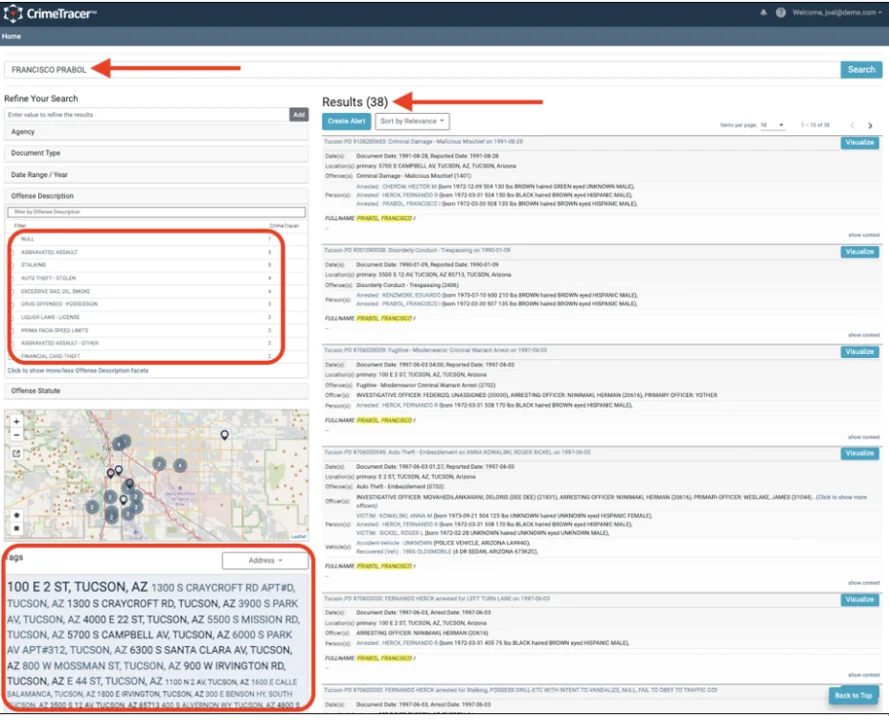
An example of a CrimeTracer Person Search and the results generated after looking up a potential suspect, Francisco Prabol.
With this contextual knowledge, officers, whether in a patrol car, at a residence’s doorstep, or in search of a witness to interview, can exercise the essential safety measures when informed about a violent history or past instances of resistance or assault against law enforcement. Once more, enhanced information fosters superior decision-making, thereby yielding improved results.
Key Feature # 2: Generate Tactical Leads Through an Intuitive, User-Friendly Platform, Empowering Officers and Accelerating Investigations
Some law enforcement data management systems are better suited for smaller teams, accommodating perhaps five users, while others exhibit scalability, catering to larger teams of up to 500 individuals. While Accurint Virtual Crime Center’s software undoubtedly provides robust reporting capabilities, it also presents a steep learning curve, making it more conducive to day-to-day usage by a compact team of crime analysts. While this setup can offer advantages, it also introduces the risk of information silos, potentially leaving officers reliant on their crime analyst counterparts to advance investigations.
Given this constraint, command staff seeking to empower their entire agency with data utilization should explore solutions such as CrimeTracer. Recognized as the “Google for cops,” CrimeTracer earns accolades from departments for its accessibility. Captain Aaron Yarnell of the Knox County Sheriff’s Office highlighted, “The most significant aspect of CrimeTracer is its user-friendliness. The interface is clean and simple. Our officers can navigate it with minimal instruction… it’s an intuitive database.”
Several other databases entail multiple steps, numerous logins, and frequent password changes, as Yarnell notes, posing challenges for officers accustomed to a particular investigative workflow. However, with CrimeTracer, the Knox County Sheriff’s Office managed to deploy the application seamlessly through their mobile management program for cell phones and iPads, ensuring easy accessibility for all officers and investigators within the department.
Furthermore, in addition to its overall user-friendliness, CrimeTracer’s Quick Search feature empowers officers and investigators with the necessary information to generate immediate tactical leads in the field, eliminating the dependence on the crime analyst team at the office to drive investigations forward.
A 10-second overview of CrimeTracer’s Quick Search feature
Key Feature #3: Extensive Data Sources Guarantee Thorough and Precise Search Outputs
CrimeTracer consolidates data from over 1.3 billion records, encompassing various sources such as record management systems (RMS), computer-aided dispatch (CAD) systems, license plate readers (LPRs), ShotSpotter, jail management systems (JMS), court warrant records, Thomson Reuters CLEAR data, and more, spanning both your agency’s databases and those of neighboring jurisdictions. In our discussions with agencies, we’ve discovered that this capability to access data from nearby jurisdictions is immensely beneficial. Deputy Chief David Powell emphasizes, “The significant aspect is its retrieval of police reports from other agencies. Not only does it provide insights into our local area, but it also includes reports from regions across the country. This grants a deeper understanding of individuals, their affiliations, and their activities.”
For instance, when responding to a gunfire incident, an officer may receive real-time details from a witness regarding the involved vehicle and its driver. Inputting these search parameters into CrimeTracer can yield results not only from nearby police reports but also from multiple agencies in diverse jurisdictions, sourced from various data repositories. This enhances the responding officer’s situational awareness and facilitates the generation of immediate investigative leads.
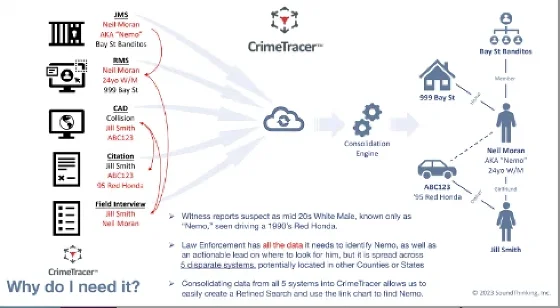
An example scenario shows how CrimeTracer can leverage data from 5 different systems across jurisdictions to produce a refined search for a suspect.
Key Feature #4: Smooth Integration with Case Management Solutions and Additional Investigative Resources
Real-time actionable intelligence often originates from details tied to existing or ongoing cases. CaseBuilder, an integral component of SoundThinking’s SafetySmart investigative platform, facilitates the creation of digital case folders wherein investigators can compile various materials including documents, scene particulars, officers’ observations, CCTV footage, citizen tips, and other pertinent information related to a case. This process generates a searchable indexed repository of evidence and gathered information.
CrimeTracer’s integration with CaseBuilder streamlines the process of initiating searches for individuals. With a single click, users can commence searches, leading to two potential outcomes:
- Exact Match: If an exact match is found, wherein the person’s name already exists in one of the law enforcement databases accessible to CrimeTracer, a single click on the individual’s profile reveals additional details such as demographics and even a mugshot. This information can be promptly attached to the corresponding entry in the CaseBuilder folder with just one click.
- Exploring Connections: Alternatively, users can leverage CrimeTracer’s functionality to unveil connections between individuals, tracing visual links and discovering relationships. For instance, it may reveal that the subject has a sibling. Pursuing this lead, investigators can further examine the sibling’s residence and identify other individuals sharing the same address. Once again, with a simple click, these newfound connections and associated information can seamlessly integrate into the CaseBuilder folder, providing actionable leads for ongoing investigative endeavors.
Importing a CrimeTracer lead into CaseBuilder – 10-second overview
Transmit and Receive Timely Alerts Enhancing Real-Time Public Safety
Criminal activities operate without pause, necessitating swift responses from law enforcement. For instance, in the event of an officer gathering leads on a shooter involved in a gun-related crime, it becomes crucial to promptly disseminate a description to fellow officers and jurisdictions.
CrimeTracer offers a Crime Bulletin feature enabling authorized agencies to upload BOLOs (Be On the Lookout) and other urgent alerts, instantly distributing them nationwide. Users can configure alerts to receive notifications whenever another agency uploads a bulletin, filtering them based on agency or other specifications. Within minutes of issuing such a bulletin, any officer utilizing CrimeTracer can locate it via search. Similarly, officers in the field with CrimeTracer can access alerts issued by other agencies, significantly enhancing officer situational awareness and public safety.
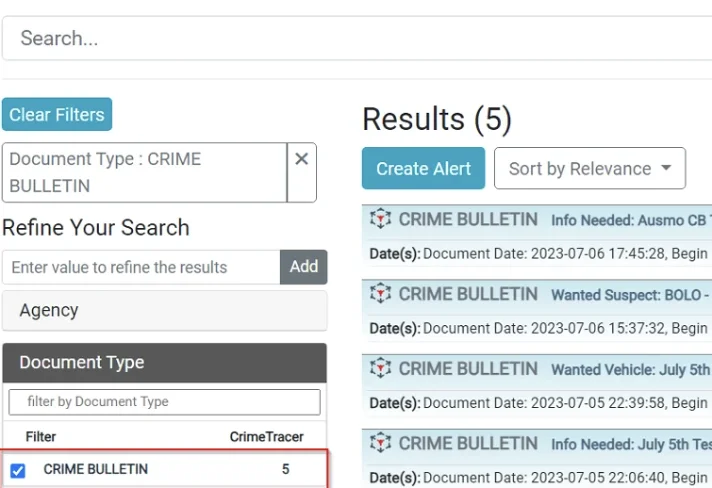
An example of recently uploaded crime bulletins.
Other Peregrine Alternatives
Peregrine Alternative # 2: Accurint Virtual Crime Center
Accurint Virtual Crime Center (AVCC), developed by the information and analytics provider LexisNexis, taps into an extensive repository of public records, akin to CrimeTracer’s ability to access Thomson Reuters CLEAR data. It furnishes users with insights into individuals and items of interest.
AVCC is primarily tailored for utilization by an agency’s crime analyst team rather than individual patrol officers in the field. Consequently, it excels in supporting ongoing investigations rather than promptly generating tactical leads. The platform boasts formidable reporting and mapping functionalities, capable of producing elaborate, visually appealing maps and charts illustrating criminal activity and trends.
A Checklist for Evaluating a Law Enforcement Search Engine and Data Management Solution
- Does the tool increase officer situational awareness and officer safety?
- Does the product empower officers and investigators to generate immediate tactical leads and expedite investigations while out in the field?
- Does the platform connect to a breadth of data sources to ensure comprehensive, accurate results?
- Does the platform integrate with case management software and other investigative tools?
- Can the platform send and receive time-sensitive alerts and notifications in real-time?
Conclusion
Amidst budget constraints and staffing deficiencies, police departments nationwide face challenges in tackling escalating crime rates. They depend on technological advancements to amplify their capabilities, rendering their endeavors more streamlined and impactful.
A law enforcement search engine and data management platform such as CrimeTracer equips field officers with the tools to enhance decision-making and drive improved results, all while prioritizing situational awareness and officer safety.


